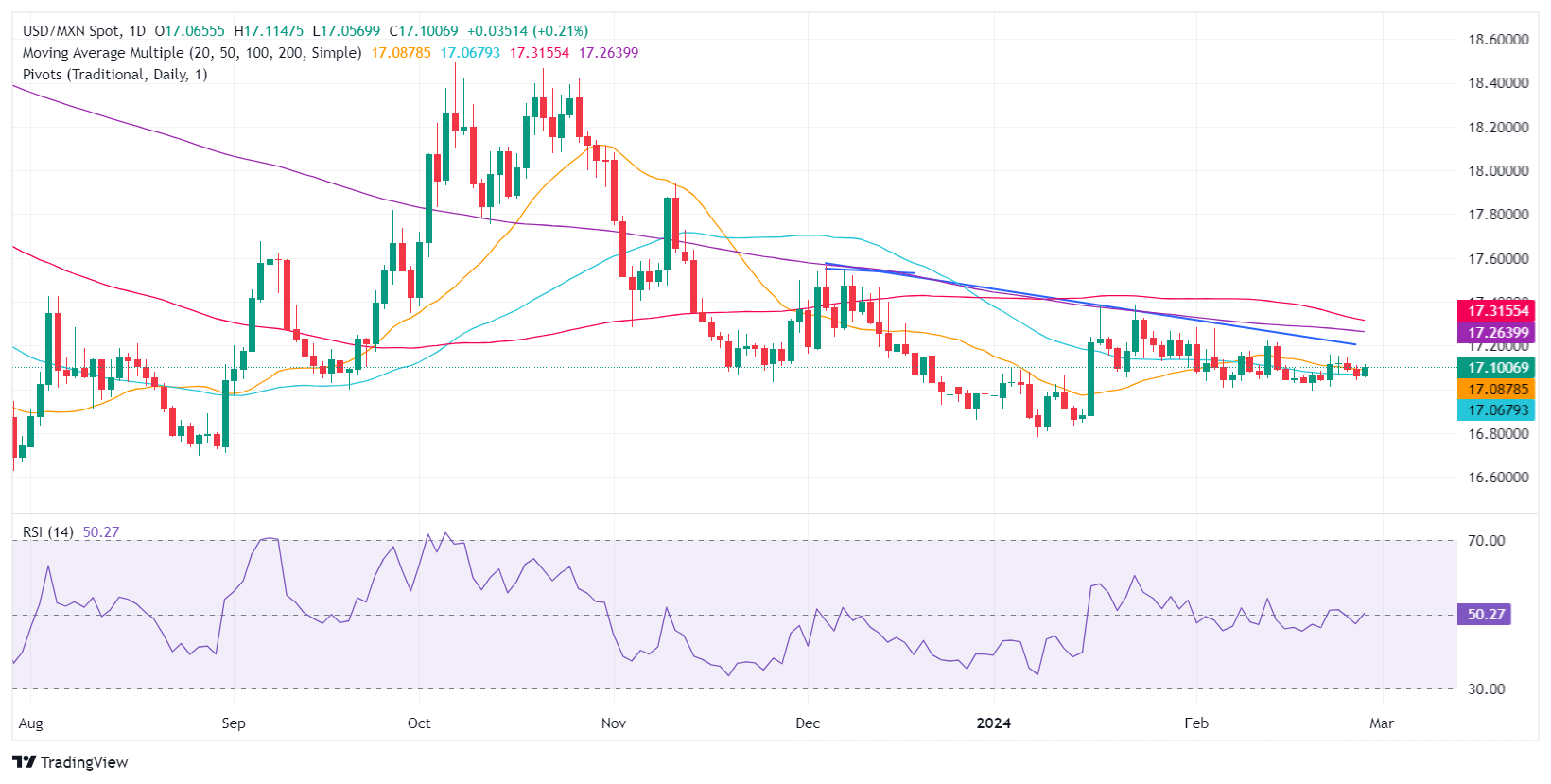- The Mexican peso falls slightly against the dollar, operators focus on Banxico's next monetary policy perspectives.
- The market anticipates 75 basis points of rate cuts by Banxico in the first half of 2024, with a view to a change to 10.50%.
- US economic data and speeches from Federal Reserve officials are the backdrop for the MXN's movements against the USD.
The Mexican peso declines against the US dollar on Wednesday, posting modest losses ahead of the Bank of Mexico (Banxico) report for the fourth quarter of 2023, which would update the monetary policy view and projections. U.S. data showed the economy expanded at a slower pace, as investors prepare for a crucial report on U.S. inflation. The USD/MXN pair trades at 17.09, up 0.21% on the day.
Mexico's economic agenda is light, except for the Banxico publication. Expectations that the Mexican central bank will ease monetary policy in March remain high, with market participants estimating 75 basis points of easing over the next six months. This means that Mexican interest rates, currently at 11.25%, would drop to 10.50% in the first half of 2024.
Across the border, in the United States, Gross Domestic Product (GDP) data for the fourth quarter of 2023 and retail and wholesale inventories for January will be published. Meanwhile, Federal Reserve (Fed) policymakers will make remarks, led by regional Fed chairs Raphael Bostic, Susan Collins and John C. Williams.
Daily Market Summary: Mexican Peso Drops Ahead of Banxico Q4 2023 Report
- The Mexican economy is expected to slow down due to the increase in interest rates set by Banxico at 11.25%. That is the main reason that caused the change of three of the five governors of the Mexican Central Bank, who point to the first rate cut at the meeting on March 21.
- In that case, the Mexican peso could depreciate, opening the door to new increases in the USD/MXN pair.
- The latest report on inflation in Mexico showed that headline and core inflation continued to decline towards Banxico's target of 3%, plus or minus 1%, while economic growth exceeded estimates but ended up below 3.3% of the third trimester.
- Mexico's economic data was released during the week of February 26 to March 1.
- The January trade balance revealed that the country recorded a trade deficit of $302 million.
- Mexico's Consumer Price Index (CPI) in the first half of February was 4.45%, below the 4.9% year-on-year.
- Mexico's core CPI slowed from 4.78% to 4.63% annually.
- Mexico's GDP for the fourth quarter of 2023 exceeded estimates of 2.4% year-on-year and reached 2.5%, down from 3.3% in the third quarter of 2023.
- Economic trade problems between Mexico and the US could depreciate the Mexican currency if the Mexican government does not resolve its steel and aluminum dispute with the United States. US Trade Representative Katherine Tai warned that the US could reimpose tariffs on these raw materials.
- Across the border, the Gross Domestic Product (GDP) for the last quarter of 2023 fell short of estimates, although it stood at 3.2% year-on-year, down from 4.9% in the third quarter.
- US retail sales inventories rose 0.3% mom in January, down from 0.4% the previous month, while wholesale inventories fell -0.1% mom, below estimates of 0.1%
- In January, US durable goods orders fell significantly to -6.1% month-on-month, exceeding the expected contraction of -4.5% and marking a steeper decline compared to the -0.3% decline in December.
- In December, the S&P/Case-Shiller home price index indicated a monthly decline of -0.3%, representing a slight acceleration in the pace of contraction from -0.2% in November. On an annual basis, house prices rose 6.1%, exceeding both expectations and the previous month's growth rate.
- Market traders had cut the odds of the first 25 basis point (bp) rate cut in June to 49%, down from 53% a day ago, while 39% of investors expected the Fed to keep rates unchanged at the current level of 5.25%-5.50%.
USD/MXN is trading above the 50-day SMA at 17.06 after the pair posted three days of losses. Relative Strength Index (RSI) studies are about to turn bullish, which could exacerbate a bullish leg towards the 17.10 area. Once surpassed, the target could be 17.20. If buyers reclaim the 200-day SMA at 17.25 and the 100-day SMA at 17.33, further upside would occur.
On the other hand, if USD/MXN falls below the 50-day SMA, we will have to wait for the 17.00 mark to be tested. If the latter breaks, investors could lose ground. A break of the latter, and the pair would fall to test yearly lows of 16.78, followed by last year's low of 16.62.
USD/MXN Price Action – Daily Chart
Banxico FAQ
What is Banxico?
The Bank of Mexico, also known as Banxico, is the country's central bank. Its mission is to preserve the value of Mexico's currency, the Mexican peso (MXN), and set monetary policy. To do this, its main objective is to maintain low and stable inflation within target levels (at or near its 3% target, the midpoint of a tolerance band between 2% and 4%).
How does the monetary policy of the Bank of Mexico influence the Mexican peso?
Banxico's main tool to guide monetary policy is the setting of interest rates. When inflation is above the target, the bank will try to control it by raising rates, making it more expensive for households and businesses to borrow money and thus cooling the economy. Higher interest rates are generally positive for the Mexican Peso (MXN), as they generate higher returns, making the country a more attractive place for investors. On the contrary, lower interest rates tend to weaken the MXN. The rate differential with the Dollar, or how Banxico is expected to set interest rates compared to the United States Federal Reserve (Fed), is a key factor.
How often does the Bank of Mexico meet during the year?
Banxico meets eight times a year and its monetary policy is greatly influenced by the decisions of the US Federal Reserve (Fed). Therefore, the central bank's decision-making committee typically meets a week after the Federal Reserve. By doing so, Banxico reacts and sometimes anticipates the monetary policy measures set by the Federal Reserve. For example, after the Covid-19 pandemic, before the Fed raised rates, Banxico did so first in an attempt to decrease the chances of a substantial depreciation of the Mexican Peso (MXN) and avoid capital outflows that could destabilize to the country.
Source: Fx Street
I am Joshua Winder, a senior-level journalist and editor at World Stock Market. I specialize in covering news related to the stock market and economic trends. With more than 8 years of experience in this field, I have become an expert in financial reporting.








